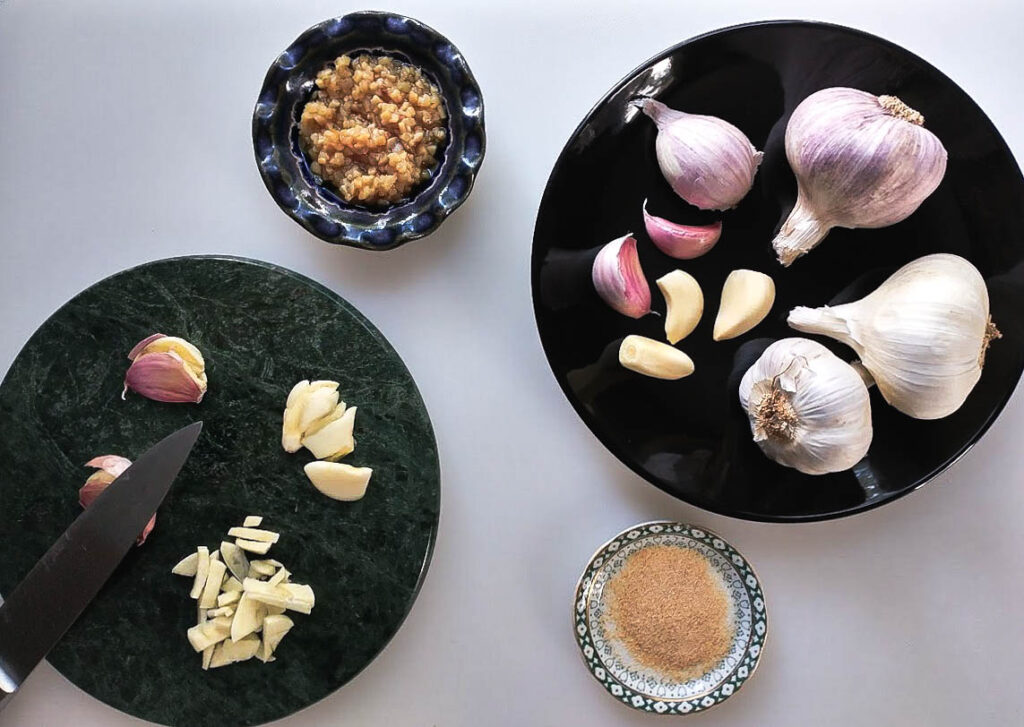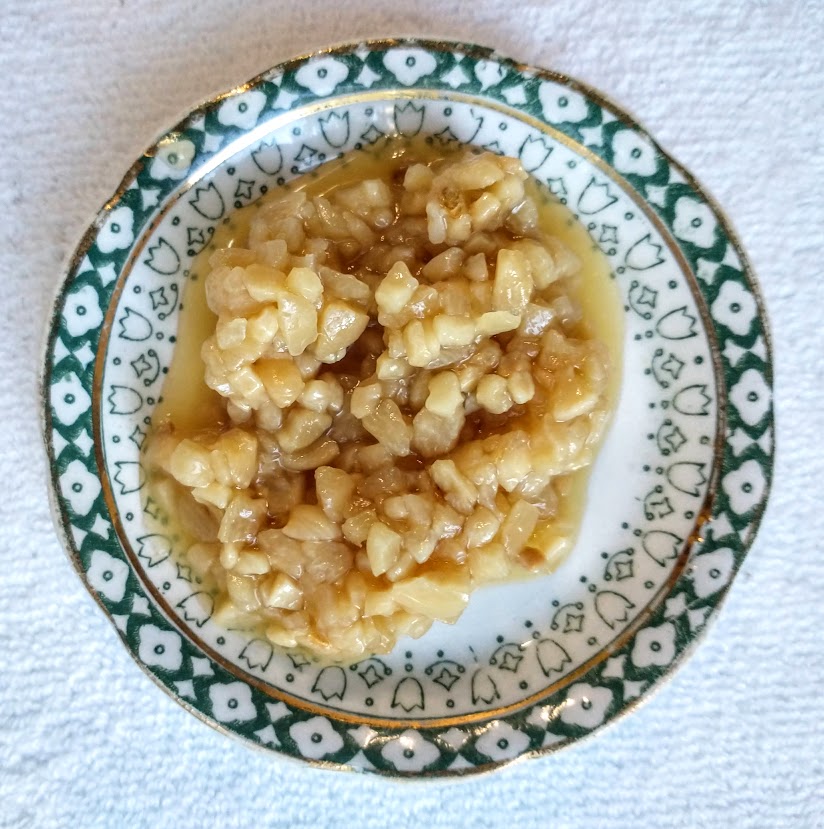
As you can see, garlic is found in many forms, sizes and colors. We are going to acquaint you with the types and forms that can be found most everywhere. This general information will suit the needs of the average dinner cook. At least, it is all WE have had to know in the many years we have been cooking dinner. Our TIIDBIT section was meant for snippets of information, but there is a lot of ground to be covered when talking garlic.
A HEAD of garlic grows as a group of CLOVES, all of which are individually wrapped in their own skin. The inside skin of a clove, is thicker than the paper-like skin on the outside of the head. Inside of the head the paper-like skin wraps around the cloves too, but the cloves are tightly wrapped in another thicker skin which is almost like a shell.

This is fresh garlic. In this picture the HEADS of garlic are placed clockwise at 1 thru 6 o’clock. As you can see, a HEAD of garlic has a thin paper-like skin, similar to an onion. They are in the same family, but garlic has a much stronger taste than an onion. It has a distinct flavor of it’s own.
The CLOVES of garlic are placed clockwise from 8 thru 11.
One of the first things to take note of, is the differences in size. The head of garlic on the bottom is a lot smaller than the other two. You may not notice the size difference of the whole head as easily as you may see the size difference of the cloves. At the 11 o’clock spot on the plate, is a SINGLE clove still wrapped in its individual thin paper-like outside layer of skin. It is huge! This size clove will come from a head that is the size next to it, or from the large white head below that. The other cloves on the left (two with skin on and 3 with the skin peeled off) would be the size expected from the smaller head on the bottom. A clove will have the skin color you see from the outside.

Here is a head of garlic, opened up. It almost looks like an unopened flower with the petals still closed tight in the pod before it opens. The cloves all connect at the root end, which is at the top of the picture. To open the head, push through the thin skin to find the edge of a clove and then kind of “crack open” the whole head. Once open, the cloves can be easily removed by twisting them from the root. As you can see, the cloves within the head, vary in size. Look at that huge one on the bottom!
Now that you are familiar with the terms used in recipes calling for fresh garlic, let’s go over some things to keep in mind when using it. When a recipe is calling for fresh garlic cloves, it is anticipated that you have an average sized head, not a huge one. If you are using a huge one, don’t use the number of cloves called for in the recipe. I would consider the huge clove in the picture to be equal to 2 regular sized cloves. Not all cloves in a head are equal in size. The cloves on the inside are smaller than those on the outside. So if you are using a recipe calling for 3 cloves and you have a huge head of garlic, you could use one of the big outside cloves in place of 2 regular sized, and break the head apart further to get a smaller one for the third. Like onions, you store garlic in a dry warm area. Preferably out of the sun. It stays fresh for quite a while, even after you have broken it open. Keep as much of the head together as possible to extend the shelf life. When cloves are no longer firm, they should be thrown out.
When cooking with fresh garlic, a whole, uncut clove, as used in our ITALIAN QUICK GRAVY, renders the mildest flavor, The smaller the chop of the garlic, the stronger the flavor is. That’s especially important to remember when you are using jarred, precut garlic as a substitute. If the recipe calls for a whole, uncut clove, use a bit less than the equivalent amount. Uncooked garlic is stronger than cooked. Ricky and I joke that there is no such thing as too much garlic, because we both like it so much, but that’s not true. Garlic can definitely overpower other flavors. You can add too much!
So, we have opened up the head of the garlic and removed a clove. Now what?

The inside skin of the clove is thick, almost like a shell, and the garlic itself is sticky. Peeling the skin off is not at easy as it may seem.
This is the method we use. On a hard surface, place a clove on it’s side. Put a knife blade flat against it. Hold the knife handle with one hand and with the other hand, push down on the flat side of the blade with your palm to crush the clove. As you can see, it breaks through the skin, making it easy to peel off. Rough chop it. If the recipe calls for a smaller chop, just chop it more from this point.
If you are going to peel the clove by hand, cut off the nub at the wide end of the clove, That is the root end. It will be a lot easier to peel off that inside shell.

This is chopped garlic from a jar. It can be found in the produce section of your grocery store. This chopped garlic was packed in water. It can also be packed in olive oil. Usually you can find bottled garlic chopped or minced, minced being the smaller cut. In cooking it doesn’t make too much difference which you have, but if you intend to add this type of garlic in a dish not cooked, such as tuna salad, potato salad, etc. the minced would incorporate better.
The most important thing to know when using jarred garlic is the equivalency measure to one clove of garlic. The jar this came from, indicates that 1/2 teaspoon is equivalent to one clove of garlic. When cut this small, garlic is very strong in flavor. You can easily add too much to a recipe. Be sure to check the label on the bottle you are using, and use a measuring spoon, not a tableware spoon. A teaspoon from your silverware drawer is usually a lot more than one measured teaspoon.
Last but not least we have garlic powder. It is a good thing to have in your kitchen cabinet. It is very versatile.

The powder that is pictured here is granulated. Some powders are ground very thin and are the consistency of confectioner’s/powdered sugar. I prefer the granulated (the consistency of regular cane sugar).
Some bottled garlic in the spice section is minced and dried. The label will indicate, in some manner, it is not powder but garlic processed in a different manner. Because Ricky and I use fresh garlic, we don’t usually use the dried counterpart.
Don’t confuse GARLIC POWDER, with GARLIC SALT. A pure garlic powder does not have salt added. One of the problems with using garlic SALT, is that you cannot regulate the two flavors when you are using it. You can easily get too much salt, while not getting enough garlic flavor. If you have used garlic SALT, and the recipe called for garlic POWDER, you definitely should not add more salt, even if the recipe calls for it. Last, but not least, garlic SALT is a rip off. It is less expensive, compared to the same sized bottle of powder, but that’s because there is so much less garlic in it! It has lots of cheap salt and a smidge of the real thing. If you need to pinch pennies (and who doesn’t these days) buy a smaller bottle of garlic powder. It’s a far better choice no matter how you look at it.
SUMMARY

